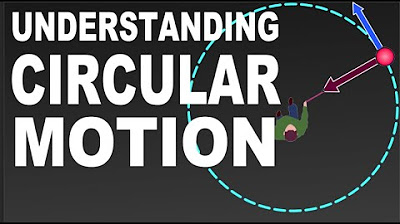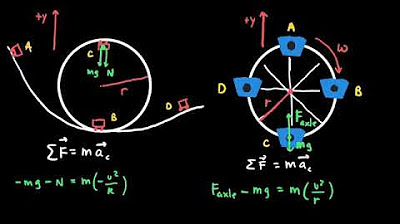Centripetal force and acceleration intuition | Physics | Khan Academy
TLDRThis educational script explores the concept of centripetal force, which is essential for objects to move in a circular path. It explains that for an object to maintain a circular trajectory with constant speed, the direction of its velocity must continually change, necessitating a force acting towards the center of the circle. The script uses examples like a yo-yo, satellites in orbit, and cars on a racetrack to illustrate how centripetal force, such as tension in a string, gravitational pull, or friction between tires and the road, keeps objects in circular motion. The explanation clarifies the difference between centripetal force, which pulls towards the center, and centrifugal force, which is often misunderstood as pushing away from the center.
Takeaways
- 🔄 An object moving in a circular path with constant speed experiences a change in the direction of its velocity, which requires a force to maintain this motion.
- 📍 The velocity vector of an object in circular motion is constantly changing direction, pointing tangentially to the path at any given point.
- 🚀 According to Newton's 1st Law, without a force acting on an object, its velocity (both magnitude and direction) would remain constant.
- 📉 The change in velocity (or acceleration) for an object in circular motion is directed towards the center of the circle, perpendicular to the velocity vector.
- 🌐 The force that acts towards the center of the circular path and causes the change in velocity is known as centripetal force.
- 🔍 Centripetal force is not the same as centrifugal force; it is an inward force that pulls the object towards the center of its circular path.
- 🌍 In real-world examples, such as a yoyo on a string or a satellite in orbit, the centripetal force is provided by tension or gravitational pull towards the center.
- 🏎️ For a car moving in a circular path on a racetrack, the centripetal force is the frictional force between the tires and the road surface.
- 🧩 The frictional force is crucial for maintaining circular motion; without it, as in the case of driving on ice, the vehicle would not turn but instead continue in a straight line.
- 🔑 Understanding the concept of centripetal force is fundamental to explaining the circular motion of objects in various everyday and scientific contexts.
Q & A
What is the significance of the object's velocity being constant in magnitude while traveling in a circular path?
-The constant magnitude of velocity indicates that the object is moving at a steady speed, but for it to travel in a circular path, the direction of its velocity must be continuously changing. This change in direction is essential for circular motion.
Why does the velocity vector's direction change when an object is in circular motion?
-The direction of the velocity vector changes because the object is constantly turning. If the direction did not change, the object would move in a straight line according to Newton's first law of motion.
What is the relationship between the direction of the force acting on an object in circular motion and the change in velocity?
-The force acting on an object in circular motion, specifically the centripetal force, must be directed towards the center of the circle. This force is responsible for the change in velocity's direction, causing the object to turn.
How does Newton's first law of motion relate to the concept of centripetal force?
-Newton's first law states that an object in motion will stay in motion at a constant velocity unless acted upon by an external force. In the case of circular motion, a centripetal force is required to change the direction of the velocity, thus keeping the object moving in a circle.
What is the direction of the centripetal force in relation to the object's motion?
-The centripetal force is always directed towards the center of the circular path. This inward force is what causes the object to accelerate towards the center, changing the direction of its velocity.
Why is the term 'centripetal force' used instead of 'centrifugal force'?
-Centripetal force is called so because it is directed towards the center of the circle ('centri-' meaning center and '-petal' meaning seeking). Centrifugal force, on the other hand, is a fictitious force that appears to act outward when observed in a rotating frame of reference and is not the same as the actual inward force required for circular motion.
What is the role of centripetal force in the example of a yo-yo being played?
-In the case of a yo-yo, the centripetal force is the tension in the string. This tension pulls the yo-yo towards the center, allowing it to move in a circular path rather than flying off in a straight line.
How does gravity act as a centripetal force for a satellite orbiting Earth?
-Gravity provides the necessary centripetal force for a satellite to maintain its circular orbit around Earth. The gravitational pull of Earth constantly pulls the satellite towards the center of the orbit, preventing it from flying off into space.
What is the centripetal force that allows a car to turn on a racetrack?
-The centripetal force in the case of a car turning on a racetrack is the frictional force between the tires and the road surface. This friction resists the car's tendency to slide sideways and allows it to turn.
Why is friction important for a car to maintain circular motion on a racetrack?
-Friction is crucial because it provides the necessary centripetal force to counteract the car's inertia and prevent it from moving in a straight line. Without friction, the car would not be able to turn and would continue moving straight ahead.
Outlines
🚀 Circular Motion and Velocity Change
This paragraph discusses the concept of an object in space moving in a circular path with a constant velocity magnitude. The speaker illustrates the changing direction of the velocity vector as the object travels around the circle, emphasizing that a continuous change in velocity direction necessitates a force acting on the object. The speaker uses Newton's first law to explain that without a force, the object would not change direction. The key takeaway is that the force required to maintain circular motion is directed towards the center of the circle, perpendicular to the velocity, which is a pattern observed as the object moves along the circular path.
🌌 Centripetal Force and Its Everyday Applications
The second paragraph delves into the concept of centripetal force, which is the inward force required to keep an object moving in a circular path. The speaker clarifies that this force is distinct from centrifugal force and is essential for circular motion. Examples provided include a yoyo on a string, where tension acts as the centripetal force, a satellite orbiting Earth held in place by gravitational force, and a car turning on a racetrack. The speaker challenges the viewer to consider the source of centripetal force in the case of a car, highlighting the importance of understanding the underlying physics in everyday scenarios.
🛣️ Friction as Centripetal Force in Circular Motion
In this paragraph, the speaker reveals that the centripetal force allowing a car to move in a circular path on a racetrack is the force of friction between the tires and the road. The speaker suggests imagining a scenario where friction is removed, such as driving on ice or oil, to understand the critical role friction plays in maintaining circular motion. This insight underscores the often-overlooked importance of friction in everyday physics and the practical implications of its presence or absence.
Mindmap
Keywords
💡Circular Path
💡Velocity Vector
💡Newton's First Law of Motion
💡Change in Velocity
💡Centripetal Force
💡Acceleration
💡Centripetal Acceleration
💡Yoyo
💡Satellite Orbit
💡Racetrack
💡Friction
Highlights
An object in space traveling in a circular path with constant velocity magnitude requires a changing velocity direction.
Velocity vector changes direction as the object moves in a circle, indicating a continuous change in velocity.
According to Newton's 1st Law, without a force, an object would not change its velocity direction or magnitude.
The force required for circular motion must act in the direction of the change in velocity.
The change in velocity vectors points towards the center of the circle, suggesting a centripetal force.
Centripetal force is perpendicular to the velocity and directed towards the center of the circular path.
Centripetal force is responsible for the inward acceleration that keeps the object moving in a circle.
The concept of centripetal force is counterintuitive, as it acts towards the center rather than away.
Centripetal force is distinct from centrifugal force, which is often confused with it.
In the case of a yoyo on a string, the tension in the string provides the centripetal force.
For satellites in orbit, Earth's gravity provides the necessary centripetal force to maintain circular motion.
Friction between tires and the road provides the centripetal force for a car moving in a circular racetrack.
Removing friction, such as driving on ice, would prevent a car from turning and maintain straight-line motion.
The force of friction is essential for circular motion in everyday scenarios like driving a car.
Understanding centripetal force is crucial for grasping the physics of circular motion in various contexts.
Transcripts
5.0 / 5 (0 votes)
Thanks for rating:





